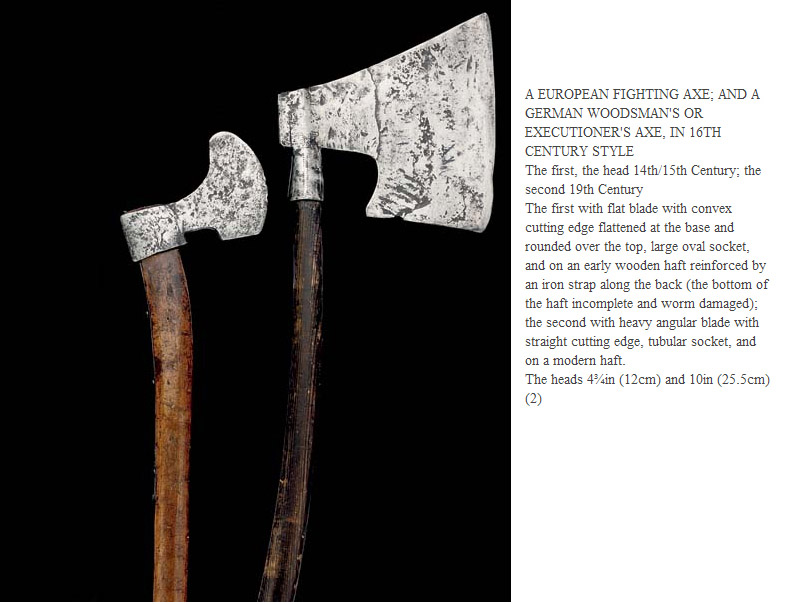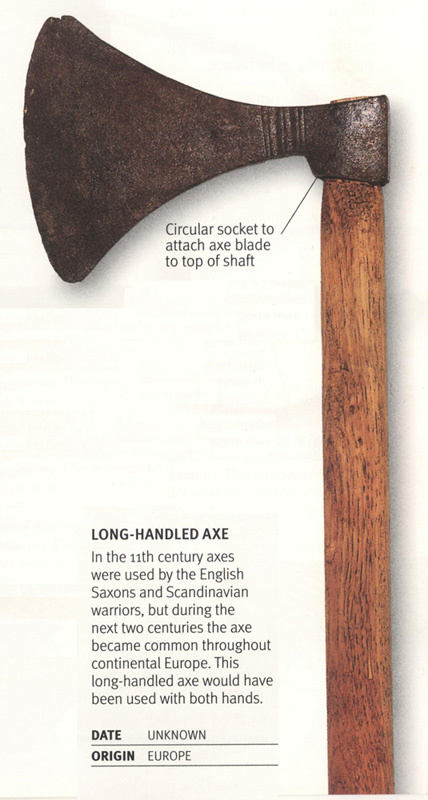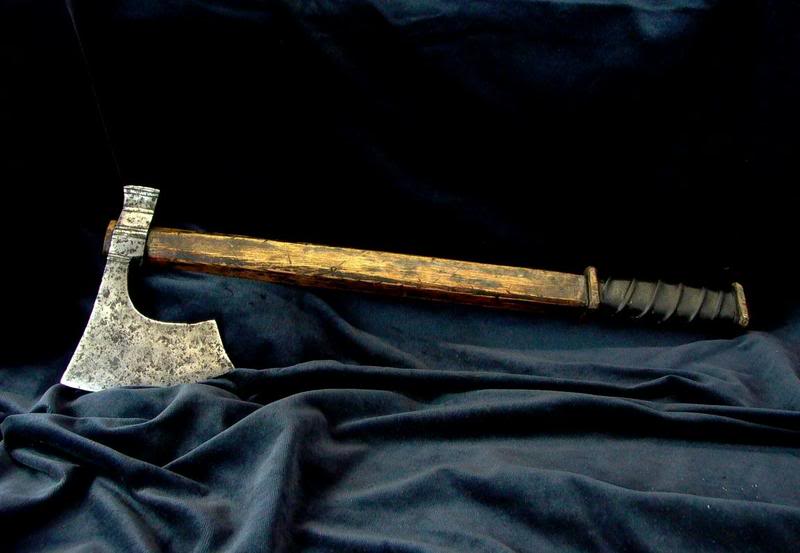| Author |
Message |
|
Malcolm A
Location: Scotland, UK Joined: 22 Mar 2005
Posts: 89
|
 Posted: Fri 23 May, 2008 6:18 am Post subject: Posted: Fri 23 May, 2008 6:18 am Post subject: |
 |
|
Message for Scott Kowalski
I may have some photos taken with a standard /simple digital camera from the right side of the Bruce Monument; if so I will certainly post them here for you.
If I don't have any, I may be able to get them quite soon as I live not too far away from Bannockburn and as my wife loves shopping in Stirling which is basically next door, the photo opportunity does exist.
Cheers to all on this great topic
It is in truth not for glory, nor riches, nor honours that we are fighting, but for freedom -- for that alone, which no honest man gives up but with life itself
|
|
  |
 |
|
Mrak E.Smith
|
 Posted: Fri 23 May, 2008 6:43 am Post subject: Posted: Fri 23 May, 2008 6:43 am Post subject: |
 |
|
| Lafayette C Curtis wrote: | Wasn't the axe particularly popular in 15th- and 16th-century for mounted use? Alas, I can't remember where I got the information from....
(It's a poke to anyone who knows better than me about the subject, and I'm sure there are quite a few people around here who would fall under that category.) |
I got most of informations on this topic from Oakeshott's European A&A from Rena 2 Inds . according to his description, the knightly horseman axe with pick, hammer or spike like a short pollaxe, similar to the Robert the Bruce's unauthentic picture posted above, was not developed until late 15th c. Before this, a axe used by soldier like Robert the Bruce is not very different from a labour's hatchet, and together with their maul,English longbowman did use it both for fighting and for making and placing stakes.I read the Osprey book of battle of Bannockburn, which has a plate showing King Bruce killed Sir Henry with a axe just like a plain "hatchet".
Btw,I can recall that the British Ironside in 17th c. also use horseman's axe to some extent, but I don't know to what extent or were they very popular.
|
|
  |
 |
|
Scott Kowalski
Location: Oak Lawn, IL USA Joined: 24 Nov 2006
Posts: 818
|
 Posted: Fri 23 May, 2008 10:54 am Post subject: Posted: Fri 23 May, 2008 10:54 am Post subject: |
 |
|
| Malcolm A wrote: | Message for Scott Kowalski
I may have some photos taken with a standard /simple digital camera from the right side of the Bruce Monument; if so I will certainly post them here for you.
If I don't have any, I may be able to get them quite soon as I live not too far away from Bannockburn and as my wife loves shopping in Stirling which is basically next door, the photo opportunity does exist.
Cheers to all on this great topic |
That would be smashing Malcolm. Any picture that you could take of the axe would be greatly appreciated by myself.
Scott
|
|
  |
 |
Craig Peters

|
 Posted: Fri 23 May, 2008 7:48 pm Post subject: Posted: Fri 23 May, 2008 7:48 pm Post subject: |
 |
|
|
I don't think there's much historical evidence to suggest Richard the Lionheart used an axe. Out of curiousity, where did the information suggesting he used an axe come from? As far as I know, Richard was known for using his lance, his sword and (when he was confined to a litter due to poor health) a crossbow.
|
|
  |
 |
|
Danny Grigg
|
|
  |
 |
Matt Lewis

Location: England Joined: 01 May 2007
Posts: 88
|
 Posted: Sun 25 May, 2008 3:32 am Post subject: Posted: Sun 25 May, 2008 3:32 am Post subject: |
 |
|
Hey Danny , thanks for the info , there has been some interesting stuff added so far, still can't find my notes :o(
I'm trying to find about uses of battle axes before say 1450 ?.
Thanks
M.
|
|
   |
 |
|
Scott Kowalski
Location: Oak Lawn, IL USA Joined: 24 Nov 2006
Posts: 818
|
 Posted: Mon 26 May, 2008 8:58 am Post subject: Posted: Mon 26 May, 2008 8:58 am Post subject: |
 |
|
Thank you for finding those Danny. Sometimes it is easy to forget just how much information is floating around on the internet.
Matt,
I think one of the hardest things is the fact that so few axes remain that can be positively dates to the time periods we are interested in. I for instance am looking for the latter half of the 13th century. Luckily there is the Maciejowski Bible that can be used to find images from.
Scott
|
|
  |
 |
|
Danny Grigg
|
|
  |
 |
|
Danny Grigg
|
 Posted: Mon 26 May, 2008 10:45 pm Post subject: Posted: Mon 26 May, 2008 10:45 pm Post subject: |
 |
|
Oops, missed the pic from George Cameron Stone's "A Glossary of the Construction...." book
See attached
Danny
 Attachment: 62.23 KB Attachment: 62.23 KB
[ Download ]
|
|
  |
 |
Matt Lewis

Location: England Joined: 01 May 2007
Posts: 88
|
 Posted: Tue 27 May, 2008 9:35 am Post subject: Posted: Tue 27 May, 2008 9:35 am Post subject: |
 |
|
My lord !! you sucked the net dry !! but seriously ,some of that stuff is perfect, joygasm :o)
Looking forward to anything else that may turn up !
|
|
   |
 |
|
Scott Kowalski
Location: Oak Lawn, IL USA Joined: 24 Nov 2006
Posts: 818
|
 Posted: Tue 27 May, 2008 2:14 pm Post subject: Posted: Tue 27 May, 2008 2:14 pm Post subject: |
 |
|
What Matt said Danny. Those are some great pictures of axes. From looking at them it seems that in some cases at least the design of the axe head did not change much from the Viking era. If you have any more by all means keep posting them. Especially if you can find any from the latter half of the 13th century.
Scott
|
|
  |
 |
|
Danny Grigg
|
 Posted: Wed 28 May, 2008 10:50 pm Post subject: Posted: Wed 28 May, 2008 10:50 pm Post subject: |
 |
|
Christie's Auction House
14th / 15th c European Axe
http://www.christies.com/LotFinder/lot_detail...ID=4953284
Christie's Auction House
2 axes - 16th and 14th century
http://www.christies.com/LotFinder/lot_detail...ID=4953286
There's a pic of a very similar axe in George Cameron Stone's "A Glossary of the Construction...." book.
The label say's 14th century. I have attached the pic.
Hermann's Historica Auction House
15th/16th century axe
http://www.hermann-historica.de/auktion/hhm53...at53_p.txt
There's a pic of a very similar hammer-axe from Ewart Oakeshott's book "European Weapons and Armour".
He states this type of axe is a late 14th century axe. I have attached the pic.
See attached 14th century axehead and macehead from the book "Arms And Armour" by Vesey Norman.
See attached pic titled "Long Handled Axe" from Dorling Kindersley Book "Weapon A Visual History of Arms And Armour".
I think this axe is from the Royal Armouries Museum in England. Can anyone confirm?
I hope these help
Danny
 Attachment: 142.98 KB Attachment: 142.98 KB

 Attachment: 132.17 KB Attachment: 132.17 KB

 Attachment: 82.67 KB Attachment: 82.67 KB
[ Download ]
 Attachment: 147.24 KB Attachment: 147.24 KB
[ Download ]
 Attachment: 140.37 KB Attachment: 140.37 KB
[ Download ]
|
|
  |
 |
Matt Lewis

Location: England Joined: 01 May 2007
Posts: 88
|
 Posted: Thu 29 May, 2008 5:34 am Post subject: Posted: Thu 29 May, 2008 5:34 am Post subject: |
 |
|
Ooh ooh ! the 14th century german axe pushes the right buttons ;o) loving your work Danny !
Something like this with a 'crows beak' , uuh huuhhuhuuuuugh ,*drbbles*
I'm going to add it to the list 
Best,
Matt
 Attachment: 82.67 KB Attachment: 82.67 KB
[ Download ]
|
|
   |
 |
|
Scott Kowalski
Location: Oak Lawn, IL USA Joined: 24 Nov 2006
Posts: 818
|
 Posted: Thu 29 May, 2008 11:08 am Post subject: Posted: Thu 29 May, 2008 11:08 am Post subject: |
 |
|
You must have the bottomless well of axe pictures Danny. I would also like to thank you for digging all of these up and also these other sources to look for additional information and images.
Scott
|
|
  |
 |
|
Scott Kowalski
Location: Oak Lawn, IL USA Joined: 24 Nov 2006
Posts: 818
|
 Posted: Tue 17 Jun, 2008 7:01 pm Post subject: Posted: Tue 17 Jun, 2008 7:01 pm Post subject: |
 |
|
I'm not sure if I should post my questions here as an extension of this post or start a new topic. If anyone thinks a new topic is in order I will start a new thread. I am starting to look into having a custom one handed axe made of a size bigger than a hand axe circa 1300. My questions that I have so far are as follows:
1. Would a grip area such as on the following axe be appropriate?

2. What would the appropriate edge type be? As shown in the following picture or more of a sword type bevel for an axe designed for use against targets both armored and unarmored?

Scott
|
|
  |
 |
|
Malcolm A
Location: Scotland, UK Joined: 22 Mar 2005
Posts: 89
|
 Posted: Mon 30 Jun, 2008 10:46 am Post subject: Posted: Mon 30 Jun, 2008 10:46 am Post subject: |
 |
|
Message for Scott Kowalski in particular
Well I finally got to Bannockburn.somewhat later than I had hoped
Am having some problems loading up a few pics of the axe that you were after
Hope this one loads up ok
Cheers
Malcolm
LOL Still having problems with te pics!
Will work on it and get back to you
It is in truth not for glory, nor riches, nor honours that we are fighting, but for freedom -- for that alone, which no honest man gives up but with life itself
|
|
  |
 |
|
Jeremy V. Krause
|
 Posted: Mon 30 Jun, 2008 2:27 pm Post subject: Posted: Mon 30 Jun, 2008 2:27 pm Post subject: |
 |
|
Gosh Danny that's a great site,
If that 12th c. axe is dated correctly that is the first axe I have seen from that specific era. There is a great deal of interesting information on this site!
I wonder how other forumites feel about the accuracy of this site. Not to offend Danny- I just like to be sure especially with all of the interesting information!
Thanks,
Jeremy
|
|
  |
 |
Nathan M Wuorio

|
 Posted: Mon 30 Jun, 2008 9:04 pm Post subject: Posted: Mon 30 Jun, 2008 9:04 pm Post subject: |
 |
|
I have a question. I had heard that the larger hand and foot axes saw extensive use from the Vikings to the Crusaders, but after that, were they a common infantry weapon? Or did the use of larger axes fade away? I know that smaller foot soldier axes and cavalry axes came into play when the sword's effectiveness against armour began to wane.
Thanks in advance.
Nathan.
|
|
  |
 |
Craig Peters

|
 Posted: Wed 02 Jul, 2008 10:29 pm Post subject: Posted: Wed 02 Jul, 2008 10:29 pm Post subject: |
 |
|
| Jeremy V. Krause wrote: | Gosh Danny that's a great site,
If that 12th c. axe is dated correctly that is the first axe I have seen from that specific era. There is a great deal of interesting information on this site!
I wonder how other forumites feel about the accuracy of this site. Not to offend Danny- I just like to be sure especially with all of the interesting information!
Thanks,
Jeremy |
Jeremy,
I have an amateur opinion ("amateur" insofar that I am not an expert in the field) on the type of axes seen in the 12th century. From what I have seen, there appears to have been two "types". The first is the classic Danish style of axe. Although I am unaware of any that can be specifically dated to the 12th century, we can confidently say they were in use at that time, simply because we have evidence of them in the 11th century and the 13th (thinking of the Maciejowski Bible in this case, although I'm sure there's other pieces of evidence too).
The second type is more interesting to me, insofar that it seems to have been a particularly 12th century form. The axe photographed on the Hurstwic page is an example of the second form. If you have a copy of Nicolle's Arms and Armor of the Crusading Era Vol I, you can find three examples of this form of axe, one of which is almost certainly a line drawing of the Hurstwic axe. These are figures 233, 236, and 961. The examples from 233 and 236 both come from Scotland, and 961 is Scandanavian in origin. Although the axe in 233 has been dated to between 1050-1100, it clearly shows elements in common with the other two axes. The difference between this form and the first form is that this later type seems to have a greater upwards sweep. This means that there is an asymmetricality in the heel and toe of the axe that is not present on the Danish axe.
Personally, I prefer the second of the two forms, just because it seems that it's particular to the 12th century while the Danish axe was in use from the 11th-13th centuries. But, either form would be an excellent choice for a reproduction axe.
|
|
  |
 |
|
Jeremy V. Krause
|
 Posted: Thu 03 Jul, 2008 9:06 am Post subject: Posted: Thu 03 Jul, 2008 9:06 am Post subject: |
 |
|
Hi Craig,
Thanks for your reply. I have always known that I need a copy of this book but have never picked one up. Hopefully someone could post the pictures you speak of. Do you believe these "other than Danish axes" would have had similar length hafts.
THis is very intriguing to me. Seems like something I will "have" to have a commission of eventually. Any weapon of thee 12th c. is primo for me!
Also I would imagine that an axe of this type would have thereinforced edge shape we see on Danish examples- due to functuality and even more so due to construction. For me the ky is finding a smith who is comfortable with working with wrought iron as mild steel really doesn't look quite the same. I want iron on my commissions whenever I can get it.
Thanks,
Jeremy
|
|
  |
 |
|
|

